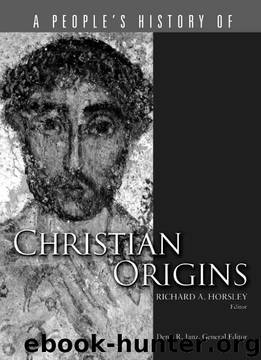Christian Origins, Volume 1 by Richard A. Horsley

Author:Richard A. Horsley
Language: eng
Format: epub
Published: 2008-08-23T03:59:00+00:00
POVERTY, FOOD, AND HEALTH
Matthew's people encounter Rome's power every day in a very practical sphere: the production, distribution, and consumption of food. How do Matthew and his people negotiate this sphere?
"For most people;" in the Roman Empire, "life was a perpetual struggle for survival. 1124 In the exploitative political-economic system of the Empire, the powerful and wealthy controlled food production, distribution, and consumption. The consumption of food expressed power, hierarchy, and injustice, with abundance for a few and deprivation for many. I will briefly summarize (and supplement) work concerning food availability, diet quality, and nutrition levels as the context in which Matthew's people live.
Two factors might suggest an adequate food supply in Rome's world. Famines were rare because both wealthy landowners and peasants employed strategies to prevent it. For example, peasants produced some surplus to trade, to store against crop failures, and to pay rents and taxes. Second, in theory, the "Mediterranean diet" was healthful." Staples of cereals, olives, wine, and legumes (beans) supplied energy, protein, vitamins B and E, calcium, and iron.
The reality, however, was quite different. Food shortages were frequent as a result of bad harvests, unfavorable weather, distribution difficulties, speculation by traders (see Philostratus, Life of Apollonius 1.8), wars, taxes, and so forth. Shortages meant endemic undernourishment or chronic mal nutrition, especially for the poor. Poor nutrition diminished capacity for work, reducing the earnings of laborers and capacity for manual labor among peasants. Other factors reduced the diet's actual healthfulness: availability due to harvests, distribution control, location (urbanites, about 10 percent of the Empire, relied largely on the surrounding chora or territo- rium or lands), seasonal variations, high prices, storage limitations, limited range of foods (resulting in deficiencies in vitamins), varying qualities of wine and cereals, and low social status.
The poor food supply is reflected in pervasive diseases of deficiency and contagion. Widespread malnutrition among nonelites26 was evident in deficiency diseases such as painful bladder stones (linked to limited animal products), eye diseases (vitamin A deficiency, diets low in animal-derived products and green vegetables), and rickets (limb deformity, deficiency in vitamin D, difficulty absorbing nutrients like calcium and iron). Early weaning of infants and the denial of protein-rich, infection-fighting colostrum to newborns meant early experience of nutritionally inadequate foods. Skeletal remains evidence considerable malnutrition.
Malnutrition rendered people vulnerable to infectious diseases such as malaria, diarrhea, dysentery, cholera, typhus, and the plague bacillus meningitis. High population densities in cities, inadequate sewage and garbage disposal, limited sanitation with restricted water supply, inadequate water distribution and unhygienic storage, public baths, animal feces, flies, mosquitoes and other insects, and so on ensured widespread infection. Swollen eyes, skin rashes, lost limbs, measles, mumps, scarlet fever, and smallpox affected many.
Matthew's Gospel and the experience of Matthew's people clearly resonate with important aspects of the above discussion.
Food production, distribution and trade, and consumption and diet figure prominently in the Gospel. Matthew depicts the imperial world's land-based economy and reliance on agriculture for food with references to sowing seed (13:3-9, 18-24), harvesting (12:1), vineyards (20:1-16; 21:
Download
This site does not store any files on its server. We only index and link to content provided by other sites. Please contact the content providers to delete copyright contents if any and email us, we'll remove relevant links or contents immediately.
The Gnostic Gospels by Pagels Elaine(2399)
Jesus by Paul Johnson(2229)
Devil, The by Almond Philip C(2205)
The Nativity by Geza Vermes(2115)
The Psychedelic Gospels: The Secret History of Hallucinogens in Christianity by Jerry B. Brown(2073)
Forensics by Val McDermid(1979)
Going Clear: Scientology, Hollywood, and the Prison of Belief by Lawrence Wright(1884)
Going Clear by Lawrence Wright(1873)
Barking to the Choir by Gregory Boyle(1729)
Old Testament History by John H. Sailhamer(1713)
Augustine: Conversions to Confessions by Robin Lane Fox(1686)
The Early Centuries - Byzantium 01 by John Julius Norwich(1655)
A History of the Franks by Gregory of Tours(1637)
The Bible Doesn't Say That by Dr. Joel M. Hoffman(1608)
Dark Mysteries of the Vatican by H. Paul Jeffers(1606)
A Prophet with Honor by William C. Martin(1603)
by Christianity & Islam(1562)
The First Crusade by Thomas Asbridge(1539)
The Amish by Steven M. Nolt(1490)
